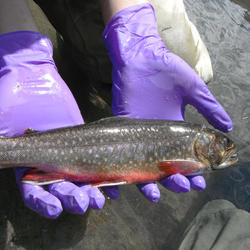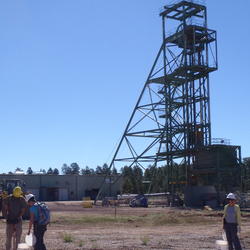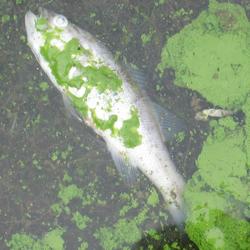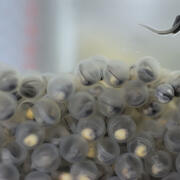Behavioral Toxicology Laboratory -- Columbia, Missouri. Swimming paths of control (left) and copper (right) exposed fish
Attractance Behavior of Asian Carp when Food Stimulus is Introduced
A rack of eight aquaria used for behavior modification studies
Video recording setup from an experimental swimming behavior assay
About the Research.
The Environmental Health Program supports scientists in the Behavioral Toxicology Core Technology Team (CTT) at the Columbia Environmental Research Center. The scientists identify how contaminants alter the behavior of organisms and what implication those changes may have on individuals, populations, and communities.
Behavioral methodology is becoming increasingly important in assessing the health and viability of natural populations to understand the challenges posed by natural stressors and to support conservation and recovery efforts.

Sublethal toxicity testing and sensitive whole organism endpoints, like behavior and neuromotor function, are of emerging importance in the field of ecotoxicology. Behavioral responses are mediated through the integration of neural, neuroendocrine and neuromuscular signals, contributing to complex and highly variable inter-individual responses in exposed organisms. These overarching themes in the field of animal behavior can be universally applied across toxicological agents, model organisms, organism life stage and endpoints.
The Behavioral Toxicology CTT has utilized its behavioral expertise and facilities to study a wide range of questions related to behavior directly related to contaminants - providing tools to better understand the effects of contaminants on behavior and how they might translate to effects on growth, reproduction, and population size.

Key Instrumentation and Capabilities
- Laboratory dedicated to behavior research
- Two proportional diluters equipped with high-definition cameras for quantifying swimming activity across chemical concentration gradients
- Five (3 small and 2 large) respirometers for measuring swimming performance
- Five countercurrent avoidance chambers for characterizing avoidance or attractance to stimuli
- Electro-olfactogram recordings (olfactory cues)
- High-throughput chamber for tracking behavior of small organisms

Current Science Questions and Activities
- International collaboration to standardize the zebrafish dark/light transition test.
- What effects do algal toxins have on fish health including sublethal and behavioral endpoints?
- What effects does thiamine deficiency have on fish behavior and can these effects be reversed with supplementation?
- Does carbamazepine, an anticonvulsant pharmaceutical, alter fish eye development and behavior?
Environmental Health Integrated Science Team Collaborators
-
Fishing and Hunting Integrated Science Team
The Fishing and Hunting integrated science team focuses on contaminant and pathogen exposures in the environment that could impact the presence and vitality of fish and wildlife populations that drive commercial, recreational and subsistence activities such as hunting and fishing. If actual risks are identified this project will inform how to economically and effectively minimize risk by providing...Energy Integrated Science Team
The Energy Lifecycle Integrated Science Team focuses on the potential for contaminant exposures in the environment that might originate from energy resource activities including, extraction, production, transportation, storage, extraction, waste management and restoration. Perceived health risks to humans and other organisms will be distinguished from actual risks, if any. If actual risks are...Minerals Science Team
The Minerals Integrated Science Team focuses on contaminant exposures in the environment that might originate from mineral resource activities including, transportation, storage, extraction and waste management. Perceived health risks to humans and other organisms will be distinguished from actual risks, if any. If actual risks are identified the science produced by this team can inform how to...Toxins and Harmful Algal Blooms Science Team
The team develops advanced methods to study factors driving algal toxin production, how and where wildlife or humans are exposed to toxins, and ecotoxicology. That information is used to develop decision tools to understand if toxin exposure leads to adverse health effects in order to protect human and wildlife health.
Science activities related to the Behavioral Toxicology Core Technology Team can be found below.
Do Trace Metal Concentrations in the Upper Columbia River Affect Early Life Stage White Sturgeon?
Clothianidin Exposure Associated with Changes in Tadpole Behavior
Data related to the Behavioral Toxicology Core Technology Team can be found below.
Behavioral Effects of Copper on Larval White Sturgeon

Behavioral Toxicology Laboratory -- Columbia, Missouri. Swimming paths of control (left) and copper (right) exposed fish

Behavioral Toxicology Laboratory — Columbia, Missouri. Screen shot of a computer monitor from a video recording setup from a swimming behavior experimental swimming behavior assay system. U.S. Geological Survey (USGS) scientists can record swimming activity of multiple treatments simultaneously in the swimming behavior assay.
Behavioral Toxicology Laboratory — Columbia, Missouri. Screen shot of a computer monitor from a video recording setup from a swimming behavior experimental swimming behavior assay system. U.S. Geological Survey (USGS) scientists can record swimming activity of multiple treatments simultaneously in the swimming behavior assay.
Scientific publications related to the Behavioral Toxicology Core Technology Team can be found below.
Ammonia and aquatic ecosystems – A review of global sources, biogeochemical cycling, and effects on fish
Copper concentrations in the upper Columbia River as a limiting factor in White Sturgeon recruitment and recovery
Effects of the neonicotinoid insecticide clothianidin on southern leopard frog (Rana sphenocephala) tadpole behavior
Behavioral effects of copper on larval white sturgeon
Potential toxicity of dissolved metal mixtures (Cd, Cu, Pb, Zn) to early life stage white sturgeon (Acipenser transmontanus) in the Upper Columbia River, Washington, United States
Sensitivity of lake sturgeon (Acipenser fulvescens) early life stages to 2,3,7,8-tetrachlorodibenzo-P-dioxin and 3,3′,4,4′,5-pentachlorobiphenyl
Quantifying fish swimming behavior in response to acute exposure of aqueous copper using computer assisted video and digital image analysis
Acute sensitivity of white sturgeon (Acipenser transmontanus) and rainbow trout (Oncorhynchus mykiss) to copper, cadmium, or zinc in water-only laboratory exposures
About the Research.
The Environmental Health Program supports scientists in the Behavioral Toxicology Core Technology Team (CTT) at the Columbia Environmental Research Center. The scientists identify how contaminants alter the behavior of organisms and what implication those changes may have on individuals, populations, and communities.
Behavioral methodology is becoming increasingly important in assessing the health and viability of natural populations to understand the challenges posed by natural stressors and to support conservation and recovery efforts.

Sublethal toxicity testing and sensitive whole organism endpoints, like behavior and neuromotor function, are of emerging importance in the field of ecotoxicology. Behavioral responses are mediated through the integration of neural, neuroendocrine and neuromuscular signals, contributing to complex and highly variable inter-individual responses in exposed organisms. These overarching themes in the field of animal behavior can be universally applied across toxicological agents, model organisms, organism life stage and endpoints.
The Behavioral Toxicology CTT has utilized its behavioral expertise and facilities to study a wide range of questions related to behavior directly related to contaminants - providing tools to better understand the effects of contaminants on behavior and how they might translate to effects on growth, reproduction, and population size.

Key Instrumentation and Capabilities
- Laboratory dedicated to behavior research
- Two proportional diluters equipped with high-definition cameras for quantifying swimming activity across chemical concentration gradients
- Five (3 small and 2 large) respirometers for measuring swimming performance
- Five countercurrent avoidance chambers for characterizing avoidance or attractance to stimuli
- Electro-olfactogram recordings (olfactory cues)
- High-throughput chamber for tracking behavior of small organisms

Current Science Questions and Activities
- International collaboration to standardize the zebrafish dark/light transition test.
- What effects do algal toxins have on fish health including sublethal and behavioral endpoints?
- What effects does thiamine deficiency have on fish behavior and can these effects be reversed with supplementation?
- Does carbamazepine, an anticonvulsant pharmaceutical, alter fish eye development and behavior?
Environmental Health Integrated Science Team Collaborators
-
Fishing and Hunting Integrated Science Team
The Fishing and Hunting integrated science team focuses on contaminant and pathogen exposures in the environment that could impact the presence and vitality of fish and wildlife populations that drive commercial, recreational and subsistence activities such as hunting and fishing. If actual risks are identified this project will inform how to economically and effectively minimize risk by providing...Energy Integrated Science Team
The Energy Lifecycle Integrated Science Team focuses on the potential for contaminant exposures in the environment that might originate from energy resource activities including, extraction, production, transportation, storage, extraction, waste management and restoration. Perceived health risks to humans and other organisms will be distinguished from actual risks, if any. If actual risks are...Minerals Science Team
The Minerals Integrated Science Team focuses on contaminant exposures in the environment that might originate from mineral resource activities including, transportation, storage, extraction and waste management. Perceived health risks to humans and other organisms will be distinguished from actual risks, if any. If actual risks are identified the science produced by this team can inform how to...Toxins and Harmful Algal Blooms Science Team
The team develops advanced methods to study factors driving algal toxin production, how and where wildlife or humans are exposed to toxins, and ecotoxicology. That information is used to develop decision tools to understand if toxin exposure leads to adverse health effects in order to protect human and wildlife health.
Science activities related to the Behavioral Toxicology Core Technology Team can be found below.
Do Trace Metal Concentrations in the Upper Columbia River Affect Early Life Stage White Sturgeon?
Clothianidin Exposure Associated with Changes in Tadpole Behavior
Data related to the Behavioral Toxicology Core Technology Team can be found below.
Behavioral Effects of Copper on Larval White Sturgeon

Behavioral Toxicology Laboratory -- Columbia, Missouri. Swimming paths of control (left) and copper (right) exposed fish
Behavioral Toxicology Laboratory -- Columbia, Missouri. Swimming paths of control (left) and copper (right) exposed fish

Behavioral Toxicology Laboratory — Columbia, Missouri. Screen shot of a computer monitor from a video recording setup from a swimming behavior experimental swimming behavior assay system. U.S. Geological Survey (USGS) scientists can record swimming activity of multiple treatments simultaneously in the swimming behavior assay.
Behavioral Toxicology Laboratory — Columbia, Missouri. Screen shot of a computer monitor from a video recording setup from a swimming behavior experimental swimming behavior assay system. U.S. Geological Survey (USGS) scientists can record swimming activity of multiple treatments simultaneously in the swimming behavior assay.
Scientific publications related to the Behavioral Toxicology Core Technology Team can be found below.







